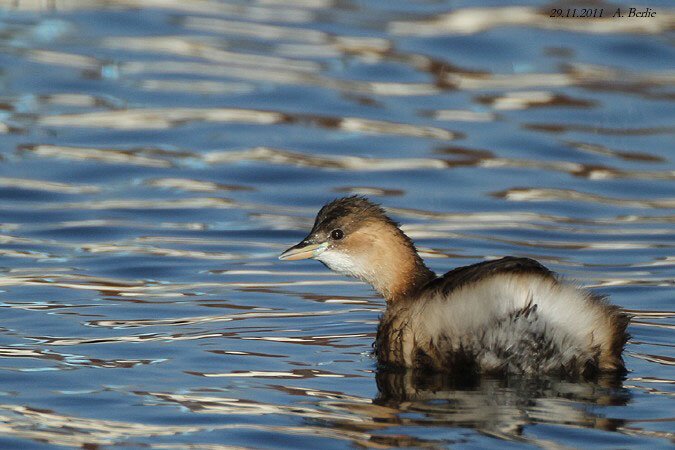LITTLE GREBE (Tachybaptus ruficollis) - Grèbe castagneux
© Frank Jarvis
SUMMARY
Small grebe with rich chestnut neck and fluffy appearance. The basic call is a rapid trill which rises in pitch and volume before trailing off:
This is almost, but not quite, the smallest of the world’s grebes (the Least Grebe of Central and South America is slightly smaller). It is a dumpy little bird with a tail that often looks like a ball of fluff. The plumage is generally a dark brownish-grey, the exception being the neck and throat which is a beautiful rich chestnut colour extending up to behind the eye (hence the specific name “ruficollis”). But this is not always obvious since it sits low in the water, often with the head drawn in. It has a pale yellow-white patch at the base of the bill and if you look carefully also at the tip of the bill. The sexes are the same in appearance, and in winter they lose their brighter colours and become mostly a drab greyish-brown colour.
Little Grebe in breeding plumage © Arlette Berlie
Despite the general appearance of a floating ball of fluff it is a very active bird, jerkily swimming about and diving very quickly to either feed or get out of the way of some threat, and it does this in the blink of an eye leaving only ripples to show where it was sitting. The generic name “Tachybaptus” is derived from ancient greek meaning “quick diving”. It is often called a “Dabchick” as an alternative English name.
Little Grebe in winter plumage © Arlette Berlie
Struggling with a large fish ! © Arllete Berlie
They mainly feed on aquatic insects, small fish, small amphibians. They are so totally aquatic that they build a nest out of floating vegetation.
It is found year-round in Western Europe, and has a range extending into sub-Saharan Africa and eastwards across Asia to the islands of Japan and New Guinea. There are a complicated mix of sub-species across range as may be expected.
It is only found in wetlands varying from small shallow lakes and slow moving rivers, to larger lakes, always preferring water bodies with dense shoreline vegetation and reed beds. In Switzerland it is found mainly below 700m asl.
Their basic call is a loud fast trill, rising to a crescendo and then tailing off. Here are two calls from single birds:
Adult with young
Both sexes care for the young which, like those of many grebes, are rather striped in colouration and when very small will ride on the back of the parents. The adults are more vocal, and territorial, in the breeding season when the pair will join together in a duet. The two birds will come together, and using both wings and feet, rise up in the water and join in song, bathing and sometimes diving after their outburst. Here are four sets of duets from different birds:
The two birds join perfectly in the duet, so it can be hard to realise there are two birds calling. Maybe you could tell in the last of those calls that the partner joined in a second after the first so the general noise level went up? Lets look in more detail at the spectrogram of that last call:
Little Grebes duetting. First bird starts at 2 secs and the second at 3 secs, both rising to the same levels. The lower trace are harmonics.
When alarmed or anxious they emit a somewhat ventriloquial and higher pitched “whit” note which you may think would come from a small passerine…
(and yes those were swans that flew over in the middle of that recording !)
Little Grebe studies © Frank Jarvis







